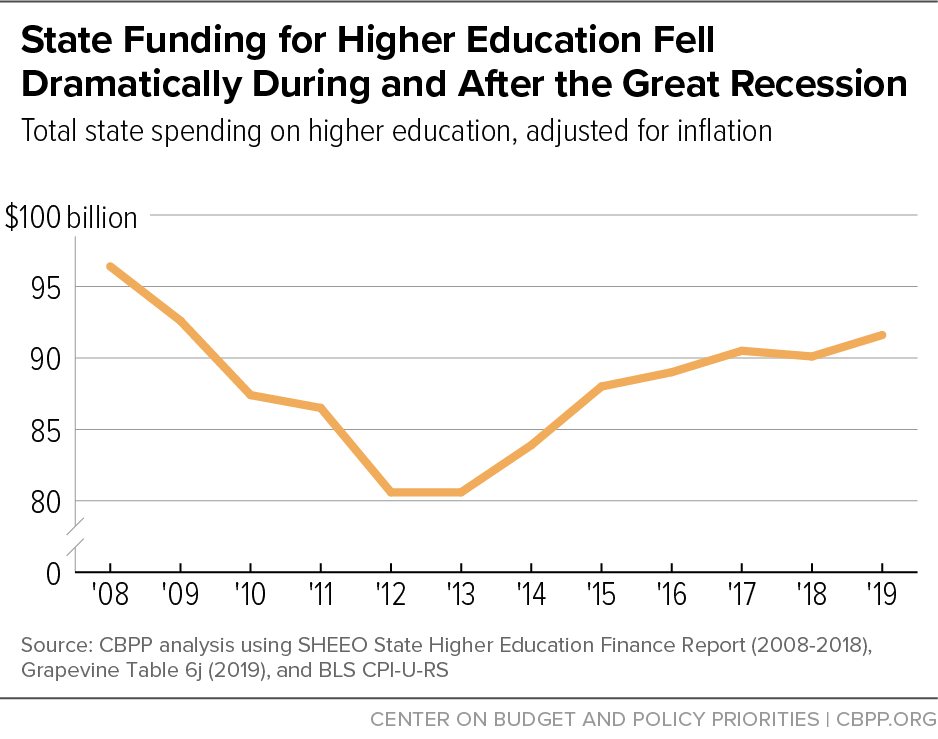BEYOND THE NUMBERS
Deep state higher education funding cuts over the last decade helped drive rapid, significant tuition increases and pushed more of college costs to students, making it harder for them to enroll and graduate, as we explain in our new report. The cuts also worsened racial and class inequality, since rising tuition deters low-income students and students of color from college. To build an economy in which the benefits of higher education are broadly shared and felt by every community regardless of race or class, state lawmakers need to invest in high-quality, affordable, and accessible public higher education.
Total state funding for public two- and four-year colleges in the school year ending in 2018 was more than $6.6 billion below what it was in 2008 as the Great Recession was fully taking hold, in inflation- adjusted terms. Funding has rebounded somewhat, but costs remain high and services in some places have not returned. (See chart.)
Between school years 2008 and 2018, after adjusting for inflation:
- 41 states spent less per student.
- On average, states spent $1,220, or 13 percent, less per student.
- Per-student funding fell by more than 30 percent in six states: Alabama, Arizona, Louisiana, Mississippi, Oklahoma, and Pennsylvania.
These deep cuts have had major consequences for public colleges and universities. States (and, to a lesser extent, localities) provide just over half of the costs of teaching and instruction at these schools. Over the last decade, higher education institutions have:
- Raised tuition. Annual published tuition at four-year public colleges has risen by $2,708, or 37 percent, since the 2008 school year.
- Reduced academic opportunities and student services. In addition to increasing tuition, public colleges and universities have dealt with state funding cuts by cutting faculty positions, eliminating course offerings, closing campuses, reducing student services, and more.
This cost shift from states to students has occurred over a period when many families — particularly those of color — have had trouble absorbing additional expenses due to stagnant or declining incomes. Since the late 1980s, tuition has been rising much faster than incomes and the sharp tuition increases since the recession have exacerbated the longer-term trend.
Moreover, the overall cost of college is rising at an untenable clip when including other costs that many students incur, such as housing, food, transportation, books and other supplies, and child care. Since the 2008 school year, the net price — published tuition and fees, room and board, and books and supplies minus the average aid a student received — at public four-year institutions across the country has risen by 24 percent, or roughly $2,920 after adjusting for inflation. This net price represents a significant share of many families’ annual earnings, particularly Black and Hispanic families in most states.
States should direct additional resources to higher education. But sufficient public investment can only occur if policymakers make sound tax and budget decisions and raise enough revenue in an equitable way. Lawmakers should also make sure that state rainy day funds are well funded, to minimize drastic cuts to higher education in the event of another economic downturn.
States should also:
- Craft smarter financial aid policies by bolstering need-based aid programs, simplifying and consolidating programs to reduce confusion and encourage greater enrollment, and ensuring that these programs encourage not only enrollment but also timely completion.
- Ensure that dollars go to the schools that need it most. Instead of creating funding models that benefit the most well-resourced schools at the expense of smaller regional institutions, as many states are doing, lawmakers should focus additional state funds on building the capacity of colleges that have fewer resources.
The potential benefits of a college degree are significant, with greater lifetime earnings for those with a bachelor’s degree relative to those with only a high school diploma. But cuts to higher education, rising tuition, and stagnant household earnings make it hard for today’s students — who are more racially and economically diverse — to secure those benefits.

